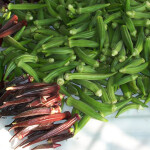Sinonim: okra; Engleski naziv: Gumbo; Latinski naziv: Hibiscus esculentus L.;
 Bamija
je jednogodišnja biljka. Sasvim mladi plodovi 3 – 6 dana nakon cvatnje i
oplodnje koriste se kao povrće na različite načine, a najviše kuhani
ili pirjani. Bamija se može konzervirati sušenjem, zamrzavanjem,
sterilizacijom i mariniranjem. U prehrambenoj industriji sasušena se
koristi kao prirodni emulgator, a djeluje i kao antioksidans. Smanjuje
kristalizaciju šećera, što se koristi u konditorskoj industriji. Zrelo
sjeme u nekim zemljama Azije i Afrike prži se kao nadomjestak kavi.
Bamija
je jednogodišnja biljka. Sasvim mladi plodovi 3 – 6 dana nakon cvatnje i
oplodnje koriste se kao povrće na različite načine, a najviše kuhani
ili pirjani. Bamija se može konzervirati sušenjem, zamrzavanjem,
sterilizacijom i mariniranjem. U prehrambenoj industriji sasušena se
koristi kao prirodni emulgator, a djeluje i kao antioksidans. Smanjuje
kristalizaciju šećera, što se koristi u konditorskoj industriji. Zrelo
sjeme u nekim zemljama Azije i Afrike prži se kao nadomjestak kavi.
Glavni korijen je dubok, a postrano se razvija u površinskom sloju tla. Stabljika je u početku zeljasta, a kasnije odrveni i može biti visoka 60 cm do 2 m. Listovi su spiralno raspoređeni, okrugli ili ovalni, trokrpasti ili peterokrpasti. Dvospolni cvjetovi (bijeli ili žuti s tamnocrvenom ili ljubičastom pjegicom) nalaze se u pazušcima listova. Plod je tobolac na kratkoj stapci.
Može se i saditi. Presadnice se uzgoje u kontejnerima u zaštićenom prostoru kroz 4 – 6 tjedana sa po 3 – 4 prava lista. Sadi se krajem travnja ili početkom svibnja, što odgovara klimatskim uvjetima našeg mediteranskog područja. Uzgaja se na gredicama širine 150 cm pokrivenim crnom PE folijom u dvoredovima s međurednim razmakom 35 cm i razmakom u redu 30 cm uz navodnjavanje kapanjem.
Plodovi vrlo brzo gube vodu i zato ih treba što prije ohladiti na oko 10 °C, pakirati u manje jedinice ambalaže, pokrivene folijom. Na prodajnom mjestu može se održati samo kratko, 2 do 3 dana na 7 °C.
Izvor: R. Lešić, J. Borošić, I. Buturac, M. Ćustić, M. Poljak, D. Romić; Povrćarstvo; Čakovec, 2002.
 Bamija
je jednogodišnja biljka. Sasvim mladi plodovi 3 – 6 dana nakon cvatnje i
oplodnje koriste se kao povrće na različite načine, a najviše kuhani
ili pirjani. Bamija se može konzervirati sušenjem, zamrzavanjem,
sterilizacijom i mariniranjem. U prehrambenoj industriji sasušena se
koristi kao prirodni emulgator, a djeluje i kao antioksidans. Smanjuje
kristalizaciju šećera, što se koristi u konditorskoj industriji. Zrelo
sjeme u nekim zemljama Azije i Afrike prži se kao nadomjestak kavi.
Bamija
je jednogodišnja biljka. Sasvim mladi plodovi 3 – 6 dana nakon cvatnje i
oplodnje koriste se kao povrće na različite načine, a najviše kuhani
ili pirjani. Bamija se može konzervirati sušenjem, zamrzavanjem,
sterilizacijom i mariniranjem. U prehrambenoj industriji sasušena se
koristi kao prirodni emulgator, a djeluje i kao antioksidans. Smanjuje
kristalizaciju šećera, što se koristi u konditorskoj industriji. Zrelo
sjeme u nekim zemljama Azije i Afrike prži se kao nadomjestak kavi.Glavni korijen je dubok, a postrano se razvija u površinskom sloju tla. Stabljika je u početku zeljasta, a kasnije odrveni i može biti visoka 60 cm do 2 m. Listovi su spiralno raspoređeni, okrugli ili ovalni, trokrpasti ili peterokrpasti. Dvospolni cvjetovi (bijeli ili žuti s tamnocrvenom ili ljubičastom pjegicom) nalaze se u pazušcima listova. Plod je tobolac na kratkoj stapci.
Agroekološki uvjeti za uzgoj bamije
Minimalna temperatura klijanja iznosi 15 – 17 °C, a optimalna 29 – 30 °C. Za vegetativni rast potrebno je najmanje 15 °C, a normalno raste tek iznad 20 °C. Temperature niže od 10 °C izazivaju jači zastoj u rastu, kao i one iznad 40 °C. I najmanji mraz uništi biljku. Može podnijeti kraće sušno razdoblje bez većeg zastoja u rastu, ali ravnomjerna opskrba vodom prijeko je potrebna za dobar prinos. Za uzgoj su najprikladnija srednje teška tla, dobre strukture uz pH 6 do 7. Ne podnosi jače kisela tla.Vezani članci - Bamija
Agrotehničke mjere u uzgoju bamije
U plodoredu bamiji odgovaraju dinje i krastavci jer imaju iste uvjete za rast i razvoj. Za dobar prinos potrebno je dosta hraniva. Preporučene količine su 600 – 800 kg/ha kombiniranog NPK gnojiva 10:20:20, uz prihranu dušikom tijekom vegetacije 2 do 3 puta sa po 20 – 30 kg/ha. Uz međurednu obradu prema potrebi se prorjeđuje (u proljeće) na planirani broj biljaka. Ljeti se zalijeva, prihranjuje i biljke se vežu za potporanj.Sjetva / sadnja bamije
Bamija se sije kada prođe opasnost od proljetnih mrazeva, a kada tlo na 5 cm dubine postigne temperaturu višu od 15 °C. Sije se na otvoreno, uz međuredni razmak 60 – 100 cm i razmak u redu 20 – 30 cm, na dubinu 2 – 3 cm. Prije sjetve korisno je sjeme namočiti kroz 24 sata u toplu vodu (oko 30 °C), što će omekšati sjemensku ljusku. Za 1 ha potrebno je 5 – 10 kg sjemena. Cvatnja počinje 6 – 8 tjedana nakon sjetve, a ubrzo nakon toga i berba.Može se i saditi. Presadnice se uzgoje u kontejnerima u zaštićenom prostoru kroz 4 – 6 tjedana sa po 3 – 4 prava lista. Sadi se krajem travnja ili početkom svibnja, što odgovara klimatskim uvjetima našeg mediteranskog područja. Uzgaja se na gredicama širine 150 cm pokrivenim crnom PE folijom u dvoredovima s međurednim razmakom 35 cm i razmakom u redu 30 cm uz navodnjavanje kapanjem.
Berba i skladištenje bamije
Berba počinje krajem svibnja ili početkom lipnja i traje do kraja rujna ili početka listopada. Uz berbu plodova dužine 7,5 – 9 cm, tri puta tjedno na ovaj se način može postići prinos od 20 t/ha. Plodovi se beru ručno, tako da se plod malo zaokrene i otkine. Problem može biti i pojava alergijske reakcije kod pojedinih berača od sitnih dlačica na cijeloj biljci.Plodovi vrlo brzo gube vodu i zato ih treba što prije ohladiti na oko 10 °C, pakirati u manje jedinice ambalaže, pokrivene folijom. Na prodajnom mjestu može se održati samo kratko, 2 do 3 dana na 7 °C.
Izvor: R. Lešić, J. Borošić, I. Buturac, M. Ćustić, M. Poljak, D. Romić; Povrćarstvo; Čakovec, 2002.








































